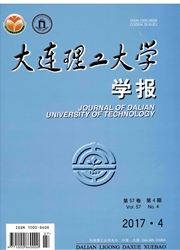

 中文摘要:
中文摘要:
以甲烷作为碳源气体,块体锰作为原料,采用一种简单的直流电弧等离子体法成功制备了Mn7Cs@C核壳型纳米粒子,用于高性能超级电容器的电极材料.所制备的Mn,C3@C核壳型纳米粒子平均直径为30-35nm.拉曼光谱结果显示石墨碳壳具有良好的导电性.通过循环伏安、恒电流充放电及电化学交流阻抗谱对Mn7C3@C核壳型纳米粒子电极材料进行电化学性能分析,结果表明其具有高比电容、快速充放电等优异的电化学性能.在扫描速率为1mV/s时,比电容最高可达185.8F/g.同时具有良好的循环稳定性,在100mV/s扫描速率下l000次循环伏安测试后,比电容仍保持为最初的88%,与单纯Mn7C3(79%)相比,有明显提高.Mn7C3@C核壳型纳米粒子电极材料优异的电化学性能归因于其良好的核壳结构,富缺陷碳层具有良好的导电性,有助于离子的传输和结构的稳定,而内核Mn,C。主要产生赝电容,在C和Mn7C3的协同作用下产生双电层和赝电容双模式储能机制.
 英文摘要:
英文摘要:
Core-shell MnTC3@C nanoparticles are synthesized successfully by a facile DC arc- discharge plasma method with CH4 as carbon source and block metal Mn as manganese material, which are used as electrode materials for high-performance supercapacitors. The as-prepared MnTC3@C mainly composes of spherical nanoparticles with a mean size of about 30-35 nm. Raman spectra provide enough evidence of high electrical conductivity of the graphitic carbon layers. The electrochemical performance of core-shell Mn7C3 @C nanoparticles electrode material is tested by cyclic voltammograms, galvanostatic charge-discharge and electrochemical impedance spectroscopy, which shows an excellent electrochemical performance, such as high specific capacitance, rapid charge- discharge and so on. The specific capacitance reaches 185. 8 F/g at the scan rate of 1 mV/s. Meanwhile, good cycle stability is obtained, where 88% of the initial specific capacitance is retained after 1 000 cycles at the scan rate of 100 mV/s, significantly improving the MnTC3 nanoparticles performance (79%). The excellent electrochemical response is attributed to a well-defined core-shell structure, where a super-conductive, defect-enriched carbon layer that fastens the ion exchange and provides stability for the structure and the pseudocapacitive contribution from Mn7C3 core, which generates an optimal dual energy storage mechanism of double-layer capacitance and pseudocapacitance.
 同期刊论文项目
同期刊论文项目
 同项目期刊论文
同项目期刊论文
 Microwave absorption and flexural properties of Fe nanoparticle/carbon fiber/epoxy resin composite p
Microwave absorption and flexural properties of Fe nanoparticle/carbon fiber/epoxy resin composite p Preparation and Electrochemical properties of Fe-Sn (C) Nanocomposites as Anode for Lithium-ion Batt
Preparation and Electrochemical properties of Fe-Sn (C) Nanocomposites as Anode for Lithium-ion Batt Core/Shell Metal/Heterogeneous Oxide Nanocapsules: The Empirical Formation Law and Tunable Electroma
Core/Shell Metal/Heterogeneous Oxide Nanocapsules: The Empirical Formation Law and Tunable Electroma Enhanced microwave absorption by arrayed carbon fibers and gradient dispersion of Fe nanoparticles i
Enhanced microwave absorption by arrayed carbon fibers and gradient dispersion of Fe nanoparticles i 期刊信息
期刊信息
